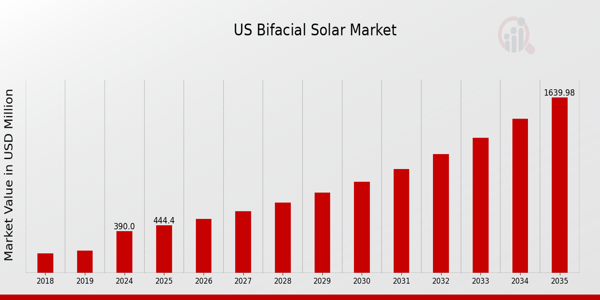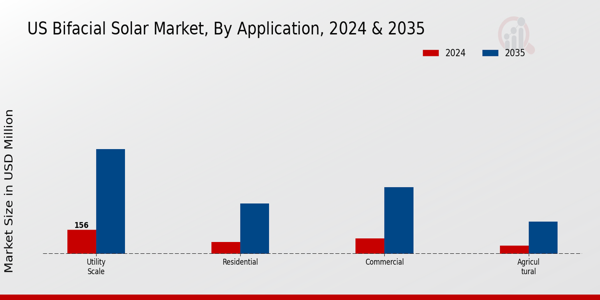US Bifacial Solar Market Overview:
As per MRFR analysis, the US Bifacial Solar Market Size was estimated at 341.25 (USD Million) in 2023. The US Bifacial Solar Market Industry is expected to grow from 390(USD Million) in 2024 to 1,640 (USD Million) by 2035. The US Bifacial Solar Market CAGR (growth rate) is expected to be around 13.948% during the forecast period (2025 - 2035).
Key US Bifacial Solar Market Trends Highlighted
The US Bifacial Solar Market is experiencing significant growth driven by advancements in solar technology and a greater emphasis on renewable energy. One of the primary market drivers is the increased efficiency of bifacial solar panels compared to traditional single-sided panels. These panels capture sunlight from both sides, making them more effective, particularly in regions with reflective surfaces. Additionally, government incentives and policies at both federal and state levels continue to support the deployment of solar energy.
The US government has established various programs aimed at promoting clean energy, further enhancing the attractiveness of bifacial solar installations.Opportunities to be explored in the US market include the potential for utility-scale projects and commercial applications, particularly in areas with ample land and high solar irradiance. As solar adoption grows, there is a clear shift towards larger installations which leverage the unique benefits of bifacial technology. Moreover, as the costs of installation and maintenance continue to decline, more homeowners and businesses are likely to consider bifacial panels as a viable option for their energy needs.
Trends in recent times show a marked increase in research and development focused on bifacial solar technology, with American companies seeking to innovate and improve efficiency through advanced manufacturing processes.Moreover, environmental awareness is pushing consumers and companies alike to move towards sustainable energy sources, leading to higher demand for solar products. As more states implement strong renewable energy targets, the bifacial solar market in the US is poised for further growth, driven by a combination of economic, environmental, and technological factors.

Source: Primary Research, Secondary Research, Market Research Future Database and Analyst Review
US Bifacial Solar Market Drivers
Increasing Demand for Renewable Energy Sources
In the United States, there is a growing emphasis on reducing reliance on fossil fuels and adopting renewable energy sources due to environmental concerns. The U.S. Energy Information Administration (EIA) has reported that renewable energy consumption has increased substantially, with solar energy accounting for a significant portion of this growth. Given that the U.S. Bifacial Solar Market Industry can produce up to 30% more energy compared to traditional monofacial panels due to its ability to harness light reflected from surfaces beneath it, this segment is likely to see considerable investments.
Additionally, the solar generation capacity of the U.S. is expected to reach triple digits (in gigawatts) by 2030, driven by policy incentives and cost reductions in solar technology. Major organizations such as the Solar Energy Industries Association (SEIA) have highlighted this trend in their reports, indicating a robust framework for the growth of the U.S. Bifacial Solar Market.
Government Incentives and Support
The federal and state governments in the U.S. have implemented various incentives to promote the adoption of solar energy, including tax credits, rebates, and subsidies. The Solar Investment Tax Credit allows homeowners and businesses to deduct 26% of the cost of installing a solar energy system from their federal taxes. This incentive has resulted in an increase in solar installations by more than 200% over the last decade, as reported by the U.S.Department of Energy. Furthermore, the recent Inflation Reduction Act includes measures specifically aimed at enhancing solar deployment, which is expected to further bolster the U.S.
Bifacial Solar Market Industry. These incentives not only make solar technology more financially viable but also stimulate job creation within the renewable energy sector.
Technological Advancements in Solar Panel Efficiency
Advancements in solar technology have significantly improved the efficiency and effectiveness of solar panels, particularly in the bifacial sector. Research and Development initiatives have led to innovations such as half-cut cell technology and improved light management techniques, increasing the average efficiency of bifacial panels to exceed 21%. The National Renewable Energy Laboratory (NREL) has indicated that these technologies can produce more electricity under various weather conditions and albedo effects.As a result, utility companies and solar developers are increasingly adopting bifacial solar panels for large-scale projects, which supports the growth of the U.S.
Bifacial Solar Market Industry and meets the energy demands of a growing population.
Increased Utility-Scale Solar Projects
The growth of utility-scale solar projects in the United States has been a significant driver for the U.S. Bifacial Solar Market. According to the EIA, utility-scale solar capacity is projected to surpass 100 gigawatts by 2024, reflecting a trend towards larger installations that can benefit from the higher energy yields provided by bifacial solar panels. Companies such as NextEra Energy and First Solar have committed to investing heavily in solar technology, recognizing the long-term benefits of bifacial designs.The integration of these systems helps utilities manage energy demands more effectively, contributing to increased operational efficiency and sustainability goals.
US Bifacial Solar Market Segment Insights:
Bifacial Solar Market Application Insights
The Application segment of the US Bifacial Solar Market encompasses diverse uses, each contributing significantly to the growth and penetration of bifacial solar technologies across various sectors. The Utility Scale applications have emerged as a key driver for the adoption of bifacial solar panels, primarily due to their ability to harness solar energy efficiently on a large scale. This segment benefits substantially from the growing demand for renewable energy solutions and is fueled by policies and incentives aimed at reducing carbon emissions.
The Commercial segment is also witnessing a notable rise, as businesses increasingly seek cost-effective solutions to meet energy needs while enhancing their sustainability profiles. Companies are incorporating bifacial solar technology into their operations to lower energy costs and improve their green credentials, representing a significant part of the overall market.Residential applications of bifacial solar panels are gaining traction as homeowners are becoming more conscious of their energy consumption and environmental impact. Many residents are now opting for rooftop installations that not only provide energy savings but also increase property value.
Furthermore, the adaptation of bifacial technology in Agricultural applications highlights its multifaceted benefits, where solar panels can coexist with crop production, optimizing land use and generating additional revenue streams for farmers. This trend aligns with the increasing focus on sustainable farming practices and the eventual shift toward energy independence for agricultural operations. Overall, the Application segment of the US Bifacial Solar Market is characterized by a compelling mix of growth drivers, including technological advancements, supportive regulatory frameworks, and an increasing emphasis on sustainability across different industries.
Each application type plays a pivotal role in the ecosystem, fostering the deployment of advanced solar technologies and reflecting the changing energy landscape in the United States. The US Bifacial Solar Market statistics show a robust trajectory, driven by the essential investment in solar infrastructure and the evolving consumer aspirations towards renewable energy solutions. As this landscape continues to evolve, we can anticipate even greater innovations and adaptations within the different applications of bifacial solar technology.

Source: Primary Research, Secondary Research, Market Research Future Database and Analyst Review
Bifacial Solar Market Technology Insights
The 'US Bifacial Solar Market' technology segment encompasses vital components such as Solar Photovoltaic Modules, Tracking Systems, and Inverters, each playing a crucial role in the market's growth. Solar Photovoltaic Modules are recognized for their efficiency in energy capture, significantly contributing to the overall power generation capacity in the United States. As technology advances, these modules are becoming increasingly effective at harnessing sunlight, thus supporting the rising demand for renewable energy.
Tracking Systems enhance the performance of solar installations by adjusting the angle of the panels to follow the sun's path, allowing for maximized energy production throughout the day.This adaptability makes them a preferred choice for many large-scale deployments, aiding in increased energy yield and reduced levelized costs of energy. Inverters are critical for converting the direct current produced by solar panels into alternating current, making it suitable for use in homes and industries.
The growth of the US Bifacial Solar Market is driven by technological advancements, favorable government policies, and a rising awareness of the environmental benefits of clean energy solutions. Together, these technologies not only dominate the market but are also key enablers of the country's transition towards sustainable energy practices.The emphasis on increasing efficiency and reducing costs positions the US Bifacial Solar Market as a significant player in the growing renewable energy landscape.
Bifacial Solar Market Material Type Insights
The Material Type segment of the US Bifacial Solar Market is witnessing significant momentum, underscored by the increasing adoption of renewable energy solutions across the region. Silicon remains a dominant player in this segment due to its established efficiency and cost-effectiveness, making it a preferred choice for various applications. Cadmium Telluride is gaining traction for its lower production costs and potential in large-scale deployments, while Copper Indium Gallium Selenide is recognized for its high absorption efficiency and flexibility, leading to a diverse range of applications.
Organic Photovoltaics, though currently less prevalent, present exciting opportunities with their lightweight and flexible properties, paving the way for innovative designs in solar technologies. The intersecting factors of innovation, cost reductions, and government support for solar energy initiatives are expected to create a favorable environment for these materials.
As trends evolve, advancements in technology will likely enhance performance metrics for these materials, driving their adoption and contributing to the overall growth of the US Bifacial Solar Market.The US aims to achieve substantial growth in renewable energy sources, highlighting the crucial role of these diverse material types in meeting sustainable energy targets.
Bifacial Solar Market Installation Type Insights
The US Bifacial Solar Market is significantly influenced by the Installation Type segment, which encompasses various configurations such as Ground Mounted, Rooftop, and Building Integrated installations. Ground Mounted systems are becoming increasingly popular due to their scalability and efficiency in harnessing solar energy, often deployed in larger solar farms. Rooftop installations, on the other hand, facilitate the integration of solar technology in residential and commercial buildings, promoting energy independence and reducing electricity costs for homeowners.
Building Integrated configurations stand out for their dual-purpose design, where solar panels are incorporated directly into building materials, enhancing the aesthetic appeal and functionality of structures while contributing to energy generation. This diversity in installation types reflects the growing adaptability of the US Bifacial Solar Market to meet different consumer needs and regulatory requirements, underpinned by increasing government incentives supporting renewable energy adoption.
The ongoing shift towards sustainable energy sources and advancements in solar technology further drive the significance of each installation type, allowing for various applications across different sectors and contributing to the overall growth of the US Bifacial Solar Market industry.This segmentation also highlights the potential for innovative solutions in the evolving landscape of renewable energy, reflecting the market's responsiveness to emerging trends and environmental challenges.
US Bifacial Solar Market Key Players and Competitive Insights:
The competitive insights of the US Bifacial Solar Market reveal a rapidly evolving landscape, driven by a heightened demand for renewable energy solutions and technological advancements in solar photovoltaic systems. As stakeholders increasingly recognize the value of bifacial solar technologywhich allows solar panels to generate electricity from both sidescompanies in the market are intensifying their efforts to establish dominance. The bifacial solar panels offer improved efficiency and a compelling return on investment compared to traditional solar solutions, leading to an influx of competitors and innovative products coming to the fore.
This dynamic environment is characterized by both established players and emerging firms, all vying for market share while adapting to regulatory changes and consumer preferences. The competitive atmosphere is further influenced by ongoing research and developments to enhance panel efficiency, durability, and installation processes. Enphase Energy stands out in the US Bifacial Solar Market due to its key strengths in innovative technology and a robust network of partnerships. The company has positioned itself as a leader in solar microinverters and energy management systems, which are critical components for optimizing bifacial solar installations.
Enphase Energy's ability to provide reliable and efficient solutions allows them to capture the interest of consumers seeking long-term energy savings. The company's focus on customer-centric products and a commitment to ongoing research and development have helped it to establish a strong presence in the increasingly competitive bifacial solar space. Furthermore, their dedication to service and support has cultivated customer loyalty, making Enphase Energy a key player in the US market dedicated to bifacial solar technology.Trina Solar is another significant entity in the US Bifacial Solar Market, renowned for its high-quality solar products and cutting-edge technology.
The company offers a wide array of bifacial solar panels designed for various applications, emphasizing their ability to boost energy yield by harnessing sunlight from both sides of the panel. Trina Solar has built a strong reputation for its commitment to sustainability and innovation, enabling it to capture a substantial market share. The company's strengths lie not only in its advanced product offerings but also in its strategic mergers and acquisitions, which have expanded its technological capabilities and market reach in the United States.
By continually investing in research and development to enhance efficiency and performance, Trina Solar has solidified its position as a key player in the bifacial solar sector. With a focus on providing comprehensive solar solutions that meet the demands of diverse consumer needs, Trina Solar remains a formidable presence in the US bifacial solar landscape.
Key Companies in the US Bifacial Solar Market Include:
US Bifacial Solar Market Industry Developments
The US Bifacial Solar Market has seen significant developments recently, with a continued push for renewable energy solutions. For instance, in September 2023, Enphase Energy announced advancements in its energy management technology to enhance bifacial panel efficiency, promoting sustainability. In August 2023, JinkoSolar unveiled a new line of bifacial solar modules, expected to boost their market presence in the US. Investment trends show that companies like First Solar and Canadian Solar are ramping up production capacities, indicating positive momentum in market valuation.
There have also been reports regarding recent acquisitions; in July 2023, Seraphim Solar announced a strategic partnership with a US-based energy firm to expand its footprint. The growth prospects for the market are also bolstered by government incentives aimed at promoting solar technology usage, aligning with the Biden administration's goal for a carbon-free power sector by 2035. Furthermore, major players like Trina Solar and Hanwha Q CELLS are investing heavily in Research and Development to enhance bifacial technology, indicating a robust trajectory for future innovations.
Overall, the US Bifacial Solar Market is pacing towards accelerating adoption driven by improvements in technology and supportive regulatory frameworks.
US Bifacial Solar Market Segmentation Insights
Bifacial Solar Market Application Outlook
Bifacial Solar Market Technology Outlook
- Solar Photovoltaic Modules
Bifacial Solar Market Material Type Outlook
- Copper Indium Gallium Selenide
Bifacial Solar Market Installation Type Outlook
Report Scope:
| Report Attribute/Metric Source: |
Details |
| MARKET SIZE 2018 |
341.25(USD Million) |
| MARKET SIZE 2024 |
390.0(USD Million) |
| MARKET SIZE 2035 |
1640.0(USD Million) |
| COMPOUND ANNUAL GROWTH RATE (CAGR) |
13.948% (2025 - 2035) |
| REPORT COVERAGE |
Revenue Forecast, Competitive Landscape, Growth Factors, and Trends |
| BASE YEAR |
2024 |
| MARKET FORECAST PERIOD |
2025 - 2035 |
| HISTORICAL DATA |
2019 - 2024 |
| MARKET FORECAST UNITS |
USD Million |
| KEY COMPANIES PROFILED |
Enphase Energy, Trina Solar, Soltec, JinkoSolar, Vivint Solar, JA Solar, First Solar, REC Group, Canadian Solar, Seraphim Solar, SunPower, GCLPoly Energy, Hanwha Q CELLS, LONGi Solar |
| SEGMENTS COVERED |
Application, Technology, Material Type, Installation Type |
| KEY MARKET OPPORTUNITIES |
Growing utility-scale installations, Enhanced efficiency through dual surfaces, Favorable government incentives, Rising energy storage integration, Expanding residential adoption |
| KEY MARKET DYNAMICS |
Government incentives and subsidies, Technological advancements in efficiency, Decreasing installation costs, Increasing utility-scale projects, Growing environmental awareness |
| COUNTRIES COVERED |
US |
Frequently Asked Questions (FAQ):
The US Bifacial Solar Market is projected to reach a valuation of 1640.0 million USD by 2035.
The expected CAGR for the US Bifacial Solar Market from 2025 to 2035 is 13.948%.
The Utility Scale application segment is forecasted to have the largest market share, valued at 676.0 million USD by 2035.
The Residential application segment is expected to be valued at 325.0 million USD by 2035.
The Commercial application segment is valued at 102.0 million USD in 2024.
Major players in the US Bifacial Solar Market include Enphase Energy, Trina Solar, JinkoSolar, and First Solar.
The Agricultural application segment is expected to reach a market value of 209.0 million USD by 2035.
The Utility Scale segment is anticipated to be valued at 156.0 million USD in 2024.
The market may face challenges such as regulatory changes and supply chain disruptions.
Growth drivers include increasing demand for renewable energy and advancements in solar technology.















